|
 Camarophyllus apricosus Camarophyllus apricosus
SynonymsHygrocybe apricosa
Hygrophorus aurantius
BiostatusPresent in region - Indigenous. Endemic
Images (click to enlarge)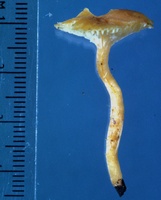
Caption: ZT1541
Owner: E. Horak: © Creative Commons Attribution-Noncommercial 3.0 New Zealand | 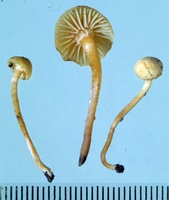
Caption: ZT0744
Owner: E. Horak: © Creative Commons Attribution-Noncommercial 3.0 New Zealand | 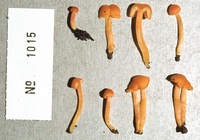
Caption: ZT1015
Owner: E. Horak: © Creative Commons Attribution-Noncommercial 3.0 New Zealand | 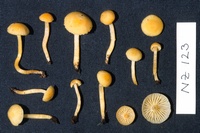
Caption: ZT9389, NZ-123
Owner: E. Horak: © Creative Commons Attribution-Noncommercial 3.0 New Zealand | 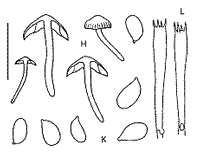
Caption: Fig. 24 Camarophyllus apricosus Horak. (H-L: PDD 27084, type):
H. basidiomes. K. spores - L. basidia | 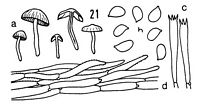
Caption: Hygrocybe apricosa Hk. (type): a. carpophores. - b. spores. - c. basidia. - d. cuticle | 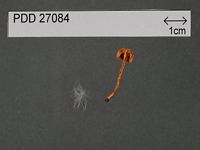
Caption: Dried type specimen
Owner: Herb PDD | 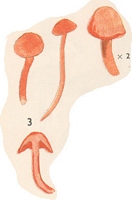 | |
Article: Horak, E. (1973). Fungi Agaricini Novazelandiae I-V. Beihefte zur Nova Hedwigia 43: 200 p.
Description: Pileus 6-18 mm diam., hemispherical when young becoming convex or campanulate, deep orange or apricot, glabrous, dry, slightly striated, not hygrophanous. Lamellae broadly adnate or decurrent with short tooth, light, apricot when young later turning deep orange, moderately distant, frequently anastomosing, gill edge concolorous, even. Stipe 10-25 x 1-2 mm, cylindric, equal, coloured like pileus, apex pruinate, towards the base with appressed fibrils, fistulose, dry, single: Context orange. Taste and odor not distinctive. Chemical reactions: on pileus: KOH, HCl and NH3 - negative.
Spores 45 x 2-2.5 µm (5-6 x 3-3.5 µm borne on 2-spored basidia), ovoid or ellipsoid, smooth, inamyloid. Basidia 32-35 x 4-5 µm, 4 and 2-spored. Cystidia absent. Cuticle a cutis of repent, cylindric hyphae (4-8 µm diam.), membrane not gelatinized but encrusted with pigment. Clamp connections numerous.
Habitat: On soil amongst mosses and litter of Weinmannia, Metrosideros, Senecio, Olearia, etc. New Zealand.
Notes: In habit, this species resembles H. aurantius Murrill ss. Stevenson (1962: 382). However, the two taxa are easily distinguished by virtue of the size and shape of their spores (see also C delicatus Hk.).
Article: Horak, E. (1990). Monograph of the New Zealand Hygrophoraceae (Agaricales). New Zealand Journal of Botany 28(3): 255-306 (http://www.rsnz.org/publish/abstracts.php).
Description: Pileus -20 mm, hemispherical to convex, with strongly incurved margin in young
specimens, becoming plano-convex or obtusely campanulate; brilliant orange (often
with brick-red or carrot-orange tinge), fading to apricot or pale yellow, dry,
glabrous, scarcely hygrophanous, substriate at margin. - lamellae -12 (1 -3)
broadly adnate-decurrent or arcuate; concolorous with pileus or paler, edges
entire, occasionally anastomosing. - Stipe 10-30 x 1-2.5 mm, cylindrical, equal
or gradually attenuating towards base; concolorous with pileus or paler (especially
towards base); dry, glabrous to minutely fibrillose, solid becoming fistulose,
single (or caespitose). - Context orange. - (Odour and taste not distinctive.
- Chemical reactions on pileus: KOH, HCl and NH3 - negative.
Spores 3-5 x (2.5-) 3-4 um, drop-shaped, occasionally ovoid, apiculus distinctly
enlarged at base. – Basidia 20-35 x 4-6 um, 4-spored (rarely 2-spored with spores
5-6 x 3-3.5 um). - Cystidia absent - Pileipellis a cutis of interwoven, cylindrical
hyphae (4-8 um diam.), membrane not gelatinised, encrusted with pigment; clamp
connections present (PL 1, Fig.5).
Habitat: ECOLOGY: Scattered (but locally common); saprobic on soil in mixed broadleaved-conifer
forests (Leptospermum, Nothofagus, Weinmannia, Metrosideros). March-June.
Distribution: DISTRIBUTION: NZ (NA, WL, STI).
Notes: Colour, size, and shape of the basidiomes are as in C. aurantiopallens
Horak which also shares its habitat with C. apricosus (Horak). The two
similar taxa however, are readily distinguished by the shape and size of the
spores.
Article: Stevenson, G. (1963) [1962]. The Agaricales of New Zealand: IV. Kew Bulletin 16(3): 373–384.
Description: Pileus 0.5-1.5 cm. diam., apricot, hemispherical to
flattened, matt; flesh apricot. Gills slightly decurrent, yellow to apricot,
moderately thick, moderately distant, rather shallow, occasionally forking with
venose folds, between. Stipe 2-4 cm. X 2-3 mm., pale apricot, smooth to silky
fibrillose, solid, rather brittle. Spores 5 X 5-6 µm. hyaline
Habitat: habitat: terrestrial under scrub and on clay banks, Wellington
Botanic Garden, 26.3.1949) & 1.7.1949, Stevenson, Rotoiti, 16,5.19561 E.
Kidson, Keith George Park, 30.5.1958, Stevenson; Otari, 7.6.1958, Stevenson;
Levin, 22.6. 1958, Stevenson.
Notes: This small apricot-coloured species with small globose spores seems fairly common
in New Zealand, though it is little known in America beyond its original description
from Florida. It has also been found in Japan (Imazeki & Hongo, 1957).
|